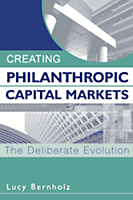The biggest opportunity for philanthropy in the next 25 years will be to proactively redesign capital markets for public benefit work. After a recent conversation with Jed Emerson, I have a hypothesis: There is more money flowing to public benefit endeavors from commercial investors and the corporate sector than from philanthropy.
That is to say, with commercial investments in alternative energy, real socially-beneficial enterprise, inner-city employment and job training efforts, and so on, the funds that are paying for things that we think of as nonprofit social goods coming from entities trying to make a buck are greater than those coming from individuals and foundations (which were about $242 BB USD in 2005).
NOW don't get me wrong -
I AM NOT saying that the commercial investments in social goods is greater than the corresponding investments in social "bads" - pollution, corrupt leadership, lousy pay, union busting, human and natural resource exploitation, etc. etc. I
am saying the capital markets for social goods are 1) not well understood, 2) not transparent, and 3) full of surprises. As long as foundations, for example, keep 95% of their assets off the table for investing in their missions, we can be pretty sure the big bucks are coming from somewhere else.
I'd love the opportunity to work with the right folks to track these revenue flows. If we can map the revenue (follow the money) we stand a much better chance of advocating for the capital market changes that
Jan Masaoka,
Clara Miller and others are calling for.













